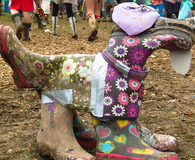DIY Bedbug Detector Is Cheap and Effective and Full of Science
Bedbugs. Ack! Just the mention may have you reaching to scratch an itch you didn't know you had. If those itches are more real than imagined, there are lots of pricey home bedbug tests and kits you can buy to confirm your suspicions or eradicate your worries. But there's a better, cheaper, DIY way to check your nest for the presence of bedbugs. (See also: Don't Let Bedbugs Take a Bite Out of Your Next Thrift Store Deal)
A trio of scientists at Rutgers University have developed a bedbug early-warning detector that's more effective than commercial tests and requires only a takeout coffee cup, a dog's water bowl, some sugar and yeast, and water.
Make Your Own Bedbug Detector
To make the detector, turn the dog bowl upside down to create a moat and a dome. Next, mix water, sugar, and yeast in the coffee cup, and rest the cup on the upturned bowl's dome. The researchers covered the outside of their bowl in cloth tape painted black; bedbugs are attracted to the color. The cloth tape made it easier for the bedbugs to climb the sloping wall before falling into the well. To trap the bedbugs inside, the researchers coated the well with sticky resin. For DIYers, a sprinkling of talcum powder will make the walls of the moat too slippery to climb back out. In fact, talc is what's used in the ClimbUp Interceptor, the most popular commercial bedbug trap on the market.
The Science Behind It
The researchers experimented with a variety of chemical bedbug attractants, but none were more effective than the simple DIY mixture. Bedbugs are drawn to the CO2 a sleeper exhales, and the combination of sugar, water, and yeast produces prodigious amounts of it — that's how beer gets its fizz and bread gets its rise. Hungry bedbugs on the prowl for CO2 and human blood crawl up the sides of the bowl and fall down into the well, never to escape. The scientists used large quantities of sugar, water, and yeast to generate the CO2 in their experiments. Smaller amounts — such as those one might mix in a paper coffee cup — are safer, although may not be as effective.
Finally, the researchers do not consider their DIY device to be a bedbug eradicator. Instead, it's an early detection tool that can warn residents of an infestation at its earliest stages, when eradication and control are more effective. If your bedbug detector reveals the beginnings of an infestation, consider calling in the pros.
Other DIY Bedbug Remedies
Aside from the aforementioned ClimbUp Interceptor, diatomaceous earth controls wandering bedbugs (and ants and other pests, too). An old folk remedy — kidney bean leaves, the tiny hairs of which impale and trap bedbug legs — may soon be available on store shelves as synthetic bean leaf bedbug traps. Or you could simply do what English philosopher John Locke is said to have done, and festoon your bed in kidney bean leaves.
Ever been beset by bedbugs? What methods have you tried to control them?
Like this article? Pin it!
Disclaimer: The links and mentions on this site may be affiliate links. But they do not affect the actual opinions and recommendations of the authors.
Wise Bread is a participant in the Amazon Services LLC Associates Program, an affiliate advertising program designed to provide a means for sites to earn advertising fees by advertising and linking to amazon.com.














Wow what a great article. Having been "attacked" by these buggers myself this is a great method. Thanks for sharing this info!
JJ
I'm very pleased to say that I haven't ran into bedbug issues. Fingers crossed that it stays that way!
Interesting, I'll have to give it a try and see if we can catch any. I sure hope not...